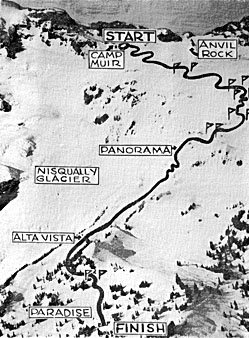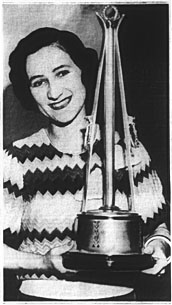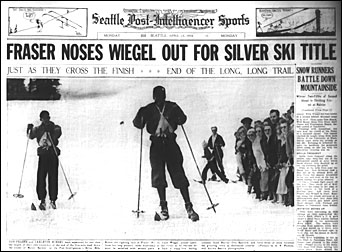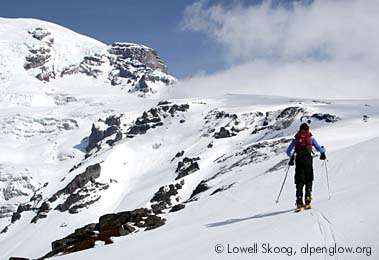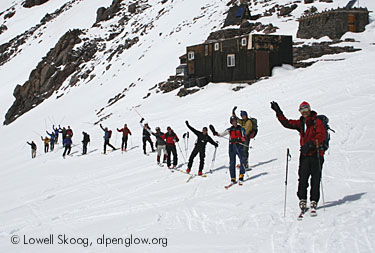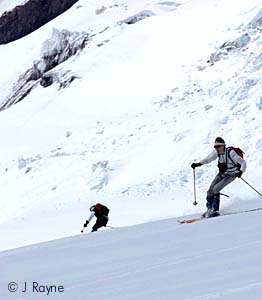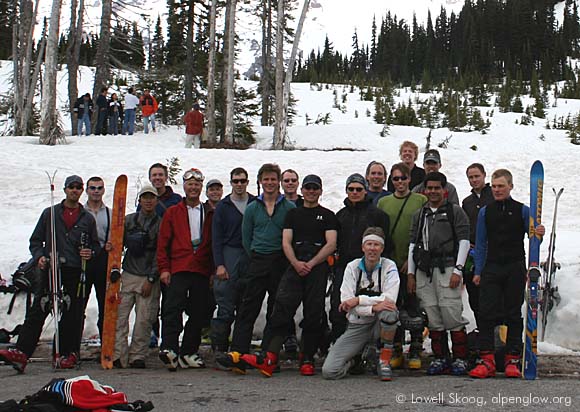|
 "All skiers
on the Silver Skis program will use the simultaneous start.
Skier Number-One will line up at the extreme left of the line looking
down the slope. Number-Two shall be immediately on his right and so on.
On the starting line competitors shall line up at least one yard apart."
"All skiers
on the Silver Skis program will use the simultaneous start.
Skier Number-One will line up at the extreme left of the line looking
down the slope. Number-Two shall be immediately on his right and so on.
On the starting line competitors shall line up at least one yard apart."
So stated the instructions for the 1934 Silver Skis, the wildest ski race ever held in North America. Other races in the "roaring thirties" may have had steeper or rougher sections, but none could match the Silver Skis for its combination of altitude, length and alpine setting. Starting at Camp Muir at 10,000 feet on Mount Rainier, the course dropped 4,600 feet in 3.6 ungroomed miles. But what really made the first Silver Skis unique was its mass start, or "geschmozzel." The most famous downhill ski race to use a mass start was the Inferno, first held in 1928 at Mürren, Switzerland. The Mürren Inferno was the brainchild of a group of ski-crazy Englishmen (and women) including ski author Arnold Lunn. This race inspired the American Inferno, introduced in 1933 at Tuckerman Ravine on Mount Washington, New Hampshire. Due to its more restricted terrain, the Mount Washington race never employed a mass start. But it gave birth to its own legend when Toni Matt schussed the Tuckerman headwall by accident in 1939 -- and survived!
The first Silver Skis, in 1934, was at once elegantly simple and insane by design. A group of Seattle-area ski boosters approached Royal Brougham, sports editor of the Seattle Post-Intelligencer, with a plan to put the Northwest on the nation's winter sports map. They proposed a downhill ski race on Mount Rainier starting a vertical mile above timberline and ending in front of the Paradise Inn. All racers would start simultaneously. The first skier to the bottom would win. Loudspeakers would be installed along the course so the crowd could follow the action. The resemblance of the first Silver Skis to a thoroughbred horse race was no accident. Brougham, an old-school newspaperman who didn't worry about the difference between reporting the news and making it, knew how to stage a spectacle. The P-I published breathless endorsements of the upcoming race and commissioned a sterling silver trophy that the winner would keep forever. As the big day approached, the paper published stories about the top entrants and announced that "almost 100 skiers" were expected to compete. Two days before the race, a P-I headline assured spectators it was "Easy to Reach Rainier." Accounts of the race vary, but all agree that at least 60 skiers assembled at Camp Muir on Sunday, April 22, 1934, and toed a line across the snowfield at 10,000 feet. Starter Otto Sanford raised a pistol high above his head, shouted a countdown, and pulled the trigger. The race was on. The top of Muir Snowfield is like a barn roof, gentle at first, but gradually steepening as one descends. Wolf Bauer later recalled, "In these first seconds there was little chance or desire to check speed until the ranks would thin out on each side. I had gone into Spartan training doing deep knee-bends during weeks of preparation in order to prevent the cramping effects of a deep crouch position against expected head winds. While this paid off in the later stages, the extra speed cost me both poles, goggles, and a broken ski still hanging precariously together with a steel-edge fastening -- result of a somersault at near sixty miles per hour. I was leading at the time, but my spot of reckoning also became the Waterloo for many behind me, in some instances with serious consequences.
"Most of us had waited too long to check speed and change course because of the traffic on all sides. When checking became imperative, the smooth snow surface suddenly changed to shingled windrows and waves, bringing about a fearsome explosion of cartwheeling humanity. It was not until the race was over that I learned how others behind me had spilled at the same time and place." Bauer managed to pick himself up, clear his head, and continue to the finish line in fifth place. Don Fraser, one of the instigators of the race and a future U.S. Olympic team member, was the winner, narrowly beating Carleton Wiegel in a time of 10 minutes 49.6 seconds. Shorter races for women and juniors were also held that day. Marguerite Strizek won the women's event and Paul Sceva Jr. won the junior race. Only one injury was reported, a fractured jaw suffered by Ben Thompson in the men's race in a collision with another racer below Anvil Rock. After 1934, wiser heads prevailed and the Silver Skis was transformed into a more conventional downhill race, with a staggered start and with individual skiers racing against the clock. The finish was moved from Paradise to Edith Creek Basin to reduce crowding and to avoid the sticky snow common at lower elevations. Still, the races continued to spawn legends. In 1935, the U.S. National Downhill Championships and Olympic team tryouts were held at Mount Rainier on a shortened course. Hannes Schroll of Austria was awarded the Silver Skis after yodelling to victory in 2 minutes, 35 seconds, over a minute faster than second place finisher Dick Durrance of Dartmouth. In 1939, Peter Radacher, an Austrian ski instructor from Sun Valley, set the course record from Camp Muir to Edith Creek Basin in just 4 minutes, 51 seconds. In 1940, tragedy struck the race when Sigurd Hall strayed off the course in fog and crashed into rocks near Little Africa, a short distance below Anvil Rock. He was killed instantly. The race went on and in 1942 Seattle fireman Matt Broze upset a field dominated by U.S. Army mountain troops training at Paradise, including many of the top ski racers in the country. World War II cancelled the Silver Skis from 1943 through 1945, but the race was revived in 1947 and 1948. The growth of skiing elsewhere in the Cascades and the difficulty of staging a race high on the cloud-swept flanks of Mount Rainier finally brought the Silver Skis to an end. Today, as climbers and ski tourers trek from Paradise to Camp Muir, the legend of the Silver Skis has almost faded from memory.
So in April 2005, I posted a note on turns-all-year.com looking for like-minded backcountry skiers to stage an informal re-enactment of the race. I knew I could go by myself to Camp Muir anytime and try to ski down fast, but schussing with a crowd of other skiers was a much more interesting and complex prospect. I guessed that a formally organized race wouldn't be welcomed by the Park Service, and I didn't want to focus too much on competition. Fortunately, a number of TAY respondents were receptive to the idea and seemed to share my attitude.
Luck was with us and the appointed day dawned clear. By mid-morning, a motley group of eighteen skiers converged at Paradise and began skinning up to Camp Muir for our pre-arranged 1 p.m. starting time. The participants were a diverse lot, from twenty-somethings eager to go all-out to forty-somethings wondering if this was a sane thing to do after a snow-drought winter with little skiing under their legs. We were bound by curiosity and a shared admiration for the pioneers whose tracks we hoped to follow. Tightening our boots at the Camp Muir shelter, we traded excuses. "I've hardly been downhill skiing at all this season," said one. "I don't know if I can even ski this without stopping, let alone race it," said another. With butterflies swirling, we spaced ourselves across the snowfield below the shelter and gave a final wave to the camera. "Geschmozzel!" we cheered as one. Then began the countdown: "Ten, nine, eight, seven, six, five, four, three, two, one, BANG!" Without a pistol, a hearty shout was the best signal the starter could make. Skis hit the fall line. Earth jerked into motion. With the world rushing up and a flurry of arms and legs accelerating beside me, I felt like a snowball swept up in an avalanche. I tried to imagine what it was like in 1934, with over sixty skiers riding a wave of leather and hickory. Out of the corner of my eye, I could see climbers on the hiking trail suddenly look up, as if to mouth, "What on earth ..."
With light, skittish touring skis, I took it easy. Ahead the gung-ho guys were pulling away in a tuck. Some made it from Camp Muir to Pebble Creek, almost 3000 feet below, without a single turn. The snow could hardly have been better -- soft and cushiony but not grabby. After our meager snow year, my ski legs were in the rubbery condition of November, but the snow was my savior. I weaved gently back and forth, watching out for skiers doing the same thing on either side of me. Anvil Rock swept by and soon McClure Rock was gone. Near Pebble Creek I passed some wreckage in a blur without recognizing it. I later learned that my brother Carl had flown off a wind ridge, nearly landing on Jason Hummel, and they both had crashed. Carl got the worst of it, but Jason was soon underway again. At Panorama Point we each took different routes through the thin, rock studded snow. A few of the leaders made wrong turns here, enabling those of us who actually turned on the upper snowfield to catch up. Near Alta Vista, I snuck up on Jason and his twin brother Josh on the boot packed trail -- old age and treachery nearly (but not quite) overcoming youth and strength. We poled furiously, see-sawing our positions as we alternately hit slippery and sticky spots. We reached the parking lot within feet of each other, with Jason and Josh just ahead of me and Bill Frans just behind. Matt Kuharic and Jan Kordel were already there, and over the next twenty to thirty minutes the rest of our crew trickled in. Everyone was safe and sound and everyone finished with a smile. With all the excitement, I forgot to run my stopwatch. Jan timed himself at nine and a quarter minutes and estimated that Matt, who arrived first, made the run in about eight and a half. Bill said that he, I and the twins finished around ten minutes, forty seconds. I was thrilled to have skied as fast as the 1934 Silver Skis winner, Don Fraser (10:49.6), yet humbled to think of his feat in much tougher conditions, with much more primitive gear.
For more history of the Silver Skis race, click here. For some impressions of the 2005 participants, click here. |
The Alpenglow Gallery
